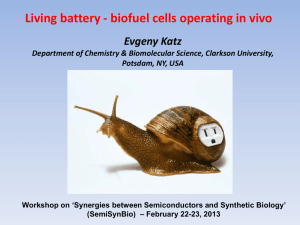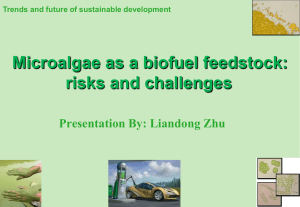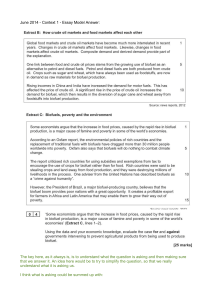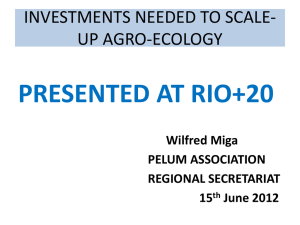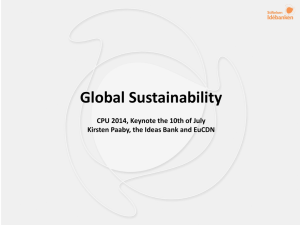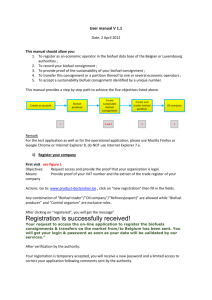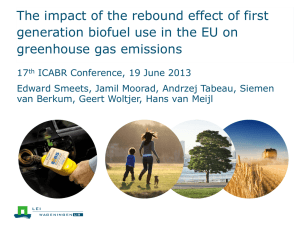View/Open - University of Nairobi
advertisement
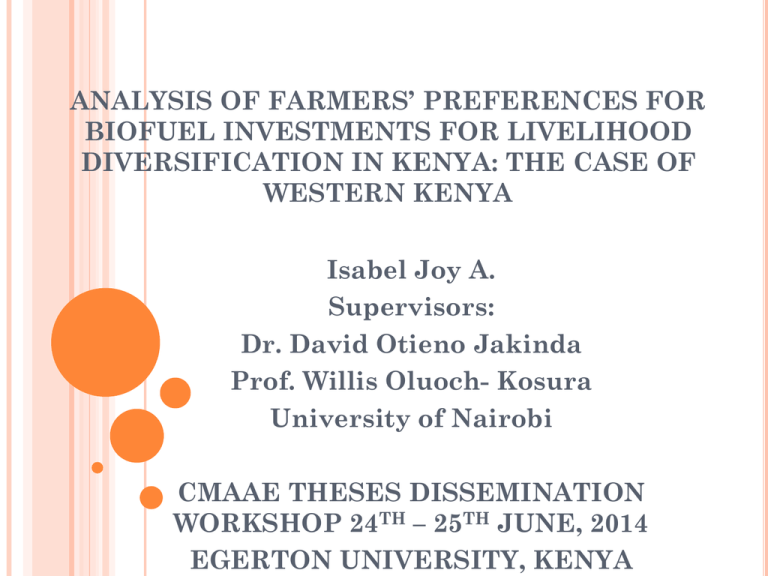
ANALYSIS OF FARMERS’ PREFERENCES FOR BIOFUEL INVESTMENTS FOR LIVELIHOOD DIVERSIFICATION IN KENYA: THE CASE OF WESTERN KENYA Isabel Joy A. Supervisors: Dr. David Otieno Jakinda Prof. Willis Oluoch- Kosura University of Nairobi CMAAE THESES DISSEMINATION WORKSHOP 24TH – 25TH JUNE, 2014 EGERTON UNIVERSITY, KENYA OUTLINE Introduction Problem statement Objectives Results INTRODUCTION Poverty continues to be a problem in many countries around the world Approximately 1.2 billion people live in extreme poverty (UN, 2012 ) Severe among small- scale farmers (IFAD, 2011) Livelihood diversification could be a possible solution (Rahut and Scharf, 2012) INTRODUCTION CONT’D Kenyan context-challenges such as high population, land pressure, low agric productivity, failed markets, Various forms of off farm diversification have emerged(rural urban migration) Limited resources to cater for growing population in urban areas (Unwin et al., 2010) Therefore, other forms of diversification have emerged not requiring rural dwellers to migrate to urban areas For example, biofuel investments are emerging as an alternative livelihood strategy-promote rural development, alternative market for crops, job creation (Darkwah et al.,2007) INTRODUCTION CONT’D Biofuel investments –lease of land, sale of land, providing labor, growing biofuel crops Kenya is exploring investments of bio fuel production. According to Sessional paper No.4 of 2004, The energy act,No.12 of 2006 and Biodiesel strategy. Recent investments towards a proposed biofuel complex aimed at producing fuel ethanol from tropical sugar beet in Western Kenya among other investments. INTRODUCTION CONT’D Biofuel investments –lease of land, sale of land, providing labor, growing biofuel crops However, farmers are not familiar with lease of land for biofuel which could come with a lot of restrictions in terms of land use and access rights that may disrupt rural livelihood patterns PROBLEM STATEMENT Persistent poverty in Western Kenya (31.5% hardcore poor) Biofuel investments are being explored by private companies and government in this region- could serve as a possible alternative livelihood strategy Lack of empirical insights on whether the investments would fit in the context of the enterprise mix of the farmers in terms of their preferences PURPOSE AND OBJECTIVES The purpose of this study was to analyse smallholder farmers’ livelihood strategies and preferences for biofuel investments in Kenya. The specific objectives were: To characterise farmers’ sources of livelihoods. To analyse farmers’ preferences for biofuel investments as an alternative livelihood strategy DATA Primary data was collected through face to face interviews CE cards collected data on preferences for biofuel investments Sampling procedure Multistage sampling in Bungoma and Kakamega regions, applied Selection of the two counties was purposive. Smaller administrative units was randomly selected. Respondents were interviewed at household level. Sample size; 180 respondents in Bungoma and 162 respondents in Kakamega; Total of 342 DATA ANALYSIS Characterization of farmers livelihood activities Descriptive statistics was done in SPSS (mean, percentages and standard deviation) Analysis of preferences for biofuel investments CE was applied through a RPL DESCRIPTIVE RESULTS Variable Bungoma Kakamega Pooled Average land size (acres) 3.12 2.62 2.70 Enterprise mix(%) •Crop farming only(maize and sugarcane) •Crop and livestock farming •Off farm activities 20.6 49.4 30 35.2 40.7 24.1 27.5 45.3 27.1 Challenges(%) •Lack of markets •Low payments •Delayed payments 75.6 73.6 72.2 12.3 50.6 49.4 45.6 62.6 61.4 Average age of household head(years) 47.3 45.7 46.4 Gender of household head (% male) 50 53.1 51.5 Average level of education (years) 9.8 8.8 9.3 Average income(kenya shillings) 4500 4900 4700 Average household size (persons) 7 6 7 Aware of biofuel (%) 51.7 30.2 41.5 Aware of sugar beet(%) 23.3 6.8 15.5 BIOFUEL INVESTMENT ATTRIBUTES ATTRIBUTE LEVELS Contract length 2 years, 5 years, 10 years Size of land 25%, 50%, 75% Employment to household members None, permanent, casual Renewability of contract Yes, No Price per acre Kshs 10,000, 15,000, 20,000 RPL MODEL The utility obtained by individual n from alternative i in choice situation z was specified according (Revel and Train 1998): Uinz = βn Xinz + εinz The marginal willingness to accept (WTA), was estimated as (Hanemann, 1984): WTA=1*(βk/βp) CE CARD Which one of the biofuel investments would you choose? Biofuel Investment alternative A Biofuel Investment alternative B 10 years 2 years Size of land 25% 75% Employment casual none Renewability of contract yes no Lease price per acre 10,000 20,000 Lease contract length Which biofuel investment would you prefer? √ Neither RPL ESTIMATES ATTRIBUTE BUNGOMA KAKAMEGA POOLED SD (POOLED) Short Long Quarter 3 quarter Permanent Casual Yes Price Likhd ratio Pseudo R2 1.86** -3.52*** 4.66*** 2.00 3.74*** 2.06*** 0.95** 0.04*** -336.13 0.57 1.68 -13.45** 13.17** 4.97 10.34*** 8.86** 0.47 0.06*** -711.90 0.59 1.47*** -3.5*** 4.41*** 1.26* 3.54*** 2.19*** 0.91*** 0.04*** -1502 0.56 2.43*** 4.41*** 2.99*** 0.27 3.47*** 1.77** 1.75*** WTA ESTIMATES (KSHS) ATTRIBUTE BUNGOMA KAKAMEGA POOLED SHORT 5,077 2,906 3,869 LONG -9,574 23,272 -9,339 QUARTE 12,654 22,791 11,559 THREEQ 5,446 8,597 3,296 PERMAN 10,161 17,898 9,264 CASUAL 5,618 15,329 5,750 YES 2,587 805 2,390 PREFERENCE HETEROGENEITY ATTRIBUTE POOLED SAMPLE SD SHORT 1.33*** 0.25 LONG -3.62*** 4.57*** QUARTER 5.71** 3.65*** THREEQUA 5.76** 0.66 PERMANEN 4.07*** 1.95*** CASUAL 2.05*** 0.99 YES 0.97*** 2.52*** LONGCRED -4.18** 4.76** CASLCRED 1.74** 0.96 PERMLAND 0.68** 0.85*** PERMHZS 0.36** 0.13* LL -752.46 PseudoR2 0.23 POLICY SCENARIOS FARMER CATEGORY ATTRIBUTES > 75% of monthly income from crop farming only Short, half, casual, yes > 75% of monthly income from crop and livestock farming Medium, quarter, none, yes > 75% of monthly income from off farm activities Long, threeqarter, permanent, yes CS ESTIMATES FARMER CATEGORY BUNGOMA (Kshs/month /acre) KAKAMEGA POOLED (Kshs/month/a SAMPLE cre) (Kshs/mont h/acre) > 75% of monthly income from crop farming only(short, half, casual, yes) 13,281.7 19,040.6 12,009.8 > 75% of monthly income from crop and livestock farming (medium, quarter, none, yes) 20,858.9 38,925.9 19,699.5 > 75% of monthly income from off farm activities (long, threequarter, permanent, yes) 6,031.9 3,223.0 3,221.6 POLICY IMPLICATIONS Study focuses on how biofuel investments companies can target different categories of farmers based on their enterprise mix. Short contract length, employment to household members and renewable contracts improve farmers’ preferences for biofuel investments ACKNOWLEDGEMENTS AERC and GOK AFRINT III PROJECT Supervisors : Dr. David Jakinda and Prof. Willis Kosura Stakeholders THANK YOU
